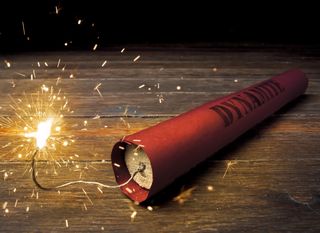
Today (May 7), marks the 150th anniversary of one of Alfred Nobel's patents for dynamite, which was first patented in 1867.
The explosive forever reshaped the world, revolutionizing warfare and construction, to the lifelong chagrin of its inventor Nobel. From its origins to its use in modern warfare to its eventual fate, here are some facts about the explosive.
Safer explosive
Though Nobel's invention was huge, it wasn't the first explosive created. Gunpowder was invented in China in the ninth century A.D., and had been used in European warfare since the 1200s. And in 1846, an Italian man, Ascanio Sobrero, had invented the highly volatile explosive nitroglycerin, according to the University of Bristol chemistry website. The process of making it was fairly simple: It involved adding glycerin to a mixture of nitric acid and sulfuric acid compounds. But nitroglycerin had a pesky habit: When it was impure it could explode without warning, and the slightest jostle could cause explosions as well, according to the University of Bristol. [Mad Genius: 10 Odd Tales About Famous Scientists]
Nobel's innovation was discovering that this volatile material, when mixed with something called kieselguhr (or diatomaceous Earth), could become stabilized, according to Nobelprize.org. The newer, safer explosive could be kneaded, just like clay, and then shaped into different forms and poured into cardboard tubes. It was much less likely to spontaneously explode, which is why Nobel dubbed it "Dynamite or Nobel's Safety Powder," in a Sept. 19, 1866 patent application, according to "Alfred Nobel, a Biography" (Arcade Publishing, 1991).
Shock wave
One of the keys to making dynamite work is finding a way to make nitroglycerin explode reliably. Nobel got the idea to use a shock wave to detonate the explosive. He figured that nitroglycerin needed rapid heating to explode, and a shock wave could provide that near-instantaneous heating. To accomplish this task, he invented the "blasting cap," or the detonator. The blasting cap initiates a smaller, feeder explosion in another explosive substance, which detonates the larger explosion. In the first prototype, the blasting cap used a wooden plug filled with black gunpowder, which was detonated with the lighting of a fuse. The explosion of gunpowder triggered the larger explosion in the dynamite.
Construction projects
Nobel himself was a builder in Stockholm, and he originally envisioned dynamite as revolutionizing construction – allowing people to blast through rock, carve out tunnels and build railroads more easily, without heavy manual labor.
However, for those types of projects, his later invention, called blasting gelatin (mostly gelatinized gelatin and some nitrocelluse), proved even more useful, though it was more expensive than dynamite and so took a while to catch on, according to "Alfred Nobel: A Biography." Blasting gelatin was as stable as dynamite and as resistant to friction and shock as dynamite; it was also as powerful as nitroglycerin, but could be used underwater, making it useful for underwater tunnel projects, according to "Alfred Nobel: A Biography."
Sign up for the Live Science daily newsletter now
Get the world’s most fascinating discoveries delivered straight to your inbox.
Use in war
However, its use as a tool of war was also obvious. Dynamite was first used in a bomb in 1870, during the Franco-German war and it soon became widespread in canons in the Spanish-American war. Nobel was not ignorant of these uses. However, Nobel continued to develop war technology even after dynamite's invention, including rockets, "smokeless powder" and canons, according to Nobelprize.org. However, he became a pacifist in his later years. Like many military strategists since, Nobel believed the invention of incredibly powerful weapons of mass destruction would serve as a deterrent that would ultimately prevent war.
"My factories may well put an end to war before your congresses. For on the day that two armies are capable of destroying each other in a second, all civilized nations will surely recoil before a war and dismiss their troops," he wrote in a letter to the famous pacifist Bertha von Suttner in 1892.
When he died in 1896, Nobel left an inheritance of 31 million Swedish krone (equivalent to $256 million today) to endow the Nobel Prizes. These prizes would go to people who had made contributions "in a wide field of knowledge and progress," according to NobelPrize.org. One hefty prize would go to a person who had "done the most or best work for the brotherhood of nations and the abolishment or reduction of standing armies, as well as for the establishment and spread of peace congresses." This would eventually become known as the Nobel Peace Prize.
Nobel, a pacifist who built one of the most powerful explosives used in warfare at the time, was a bundle of contradictions.
In his own words, he was a "misanthrope and yet utterly benevolent, have more than one screw loose yet am a super-idealist who digests philosophy more efficiently than food," according to "Alfred Nobel, a Biography."
Originally published on Live Science.

Tia is the managing editor and was previously a senior writer for Live Science. Her work has appeared in Scientific American, Wired.com and other outlets. She holds a master's degree in bioengineering from the University of Washington, a graduate certificate in science writing from UC Santa Cruz and a bachelor's degree in mechanical engineering from the University of Texas at Austin. Tia was part of a team at the Milwaukee Journal Sentinel that published the Empty Cradles series on preterm births, which won multiple awards, including the 2012 Casey Medal for Meritorious Journalism.
